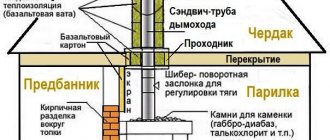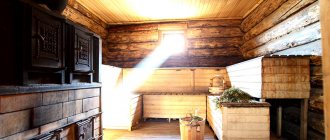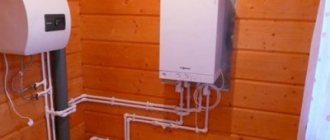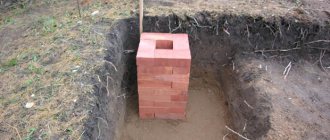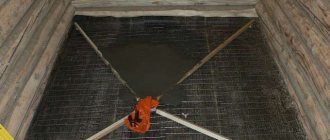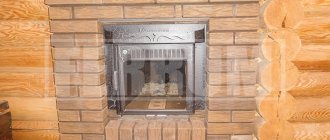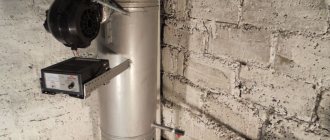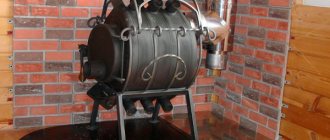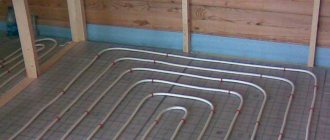Today, gas heaters are a big competitor to older wood-burning stoves. Gas stoves, unlike previous versions, are much simpler and cheaper, and after heating the room there is no debris, soot, etc. They warm up quickly, independently maintaining the desired temperature, which is important for steam rooms.
Read also: Why the stove smokes and what are the possible reasons
Cost-effectiveness is the main advantage. The heating box and chimney ducts are almost never dirty, which is also a positive side of these structures. Rules
The installations are strict, but they ensure complete safety of using the stove for 25 years. The only disadvantage of such structures is the need for a gas pipeline running next to the bathhouse.
Operating principle and differences of gas equipment
You cannot objectively judge the quality of the purchased injector. Do not disassemble the finished product in search of possible defects. So there is a chance to damage rather than check an expensive device.
By assembling each element of the burner yourself, you will receive not only pleasant satisfaction from the work done, but also savings. At the same time, the operation and repair of gas bath equipment will become safe and conscious.
The heating gas unit is a sauna stove body with a gas supply device located in it. Here are the main elements of the control mechanism with which the fuel supply is regulated.
The burner heats the air in the firebox. The thermal energy of the nozzle is transferred through the body to the tray with stones
A heating stove with a gas nozzle requires special attention to the chimney, which must be cleaned periodically.
The advantages of heating water and sauna stones with a gas burner include:
- Simplicity of the workflow. To heat up, just turn the valve and ignite the gas in the burner. In an hour, the steam room of the bathhouse will be sufficiently heated.
- Environmental friendliness. During operation of a gas device, harmful emissions during gas combustion have the smallest volume compared to other types of fuel.
- Ease of maintenance of the burner and the stove itself. There is no need to deal with soot from walls and remove waste, as with coal or firewood.
You can equip the oven with special sensors that are triggered at a critically low exhaust speed. In this case, the gas supply is automatically turned off.
Inexpensive fuel from a gasified stove allows you to not limit the number of bath procedures. Even with daily heating of the bathhouse, maintaining cleanliness becomes very easy
Such a disadvantage of a homemade burner, such as additional registration of technical permits, pays off due to high productivity. Using a gas injector will save 30% costs compared to solid fuels. Heating a sauna with gas is two times cheaper than using an electric boiler.
First heating of a combination stove
To get rid of the smell of paints and industrial oils that coat the device, it must be heated in a special way before full operation begins.
To do this, you need to open the windows and doors in the room wide, load the device for burning flammable substances to the maximum and heat the stove for one hour. The heater must remain empty.
After making sure that all structural elements are working properly and waiting for the stove to cool down, you can begin full operation.
In the future, odors present at the beginning of the combustion process will not appear.
Design features and types of burners
Important parameters of a homemade gas burner are safety, ease of manufacture, suitability for use in specific conditions, and efficiency. There are quite a lot of options for choosing modifications of the device supplying the gas mixture. They are used for heating a house, heating water boilers, even for hiking.
It is necessary to navigate this variety of types of devices in order to make a high-quality sauna burner with your own hands.
Based on the method of air entering the burner, they are conventionally divided into two types:
- Atmospheric , with natural air supply to the combustion zone.
- Fan type , with forced air supply carried out by a built-in fan. They are blown and supercharged.
For DIY production, atmospheric burners are more popular among craftsmen. The simple nozzle design can be improved with additional options. For example, equip the burner with a thermostat, draft sensors, flame control, and gas shut-off valve.
The physical parameters of both the sauna stove and the selected nozzle model should be taken into account. Before you start making the burner, decide on the dimensions
All these functions will increase the reliability and safety of operation, but at the same time they will increase the cost of your product. You will decide for yourself how appropriate the additional equipment is, based on your financial capabilities and the frequency of operation of the burner.
Atmospheric devices
Such burners are one or more hollow metal tubes through which gas fuel is supplied under pressure. Ignition is carried out using a piezo lighter. Atmospheric nozzles are the cheapest and easiest to manufacture.
Usually they make atmospheric gas burners with their own hands. Their advantages are independence from electricity and pressure drop in the gas main
The main disadvantage of atmospheric gas burners is considered to be the need for a constant high-quality air flow. It will have to be equipped additionally in the bathhouse. Typically, an ash pan or an air duct connected to it is used for this purpose.
A ventilation pipe with air intake from an adjacent room is effective. At a low draft level, most of the poorly burned fuel goes into the chimney. This poses a risk of gas leakage if there are microcracks in the brick mass.
Therefore, a brick stove with such a burner requires constant inspection and monitoring of the condition of both the stove mass itself with smoke circulation and the chimney.
Complete set of blowing devices
Fan burners are a unit with a fan, sensors and controllers. Air intake and injection from the street is carried out automatically, the operation of the equipment is controlled automatically. The combustion power in the blowing device can be adjusted according to needs.
Forced uninterrupted supply of air allows you to increase the efficiency of the heating device due to high-quality gas combustion. Accordingly, fuel consumption for heating the sauna stove is reduced.
A fan burner is more difficult to install, but easier to operate. The intensity of the nozzle in such a scheme is easier to regulate using automation
The cost of the equipment is affected by connecting the burner to electricity. In case of possible power outages, it is necessary to have an alternative source, for example, a diesel generator or battery.
Both types of gas burners can be converted from liquefied gas to main gas and vice versa. To transfer, the nozzles are replaced, due to which the volume of the gas mixture pumped into the combustion chamber changes. Replacement nozzles are selected in accordance with the manufacturer’s recommendations, or more precisely with the dimensions indicated by him.
Criteria for choosing a design option
Each type of burner has its own power and gas consumption parameters. An energy-dependent inflatable burner with more expensive components is used for heating boilers in large-volume baths.
To heat small and rarely used rooms, it is recommended to install an atmospheric burner. For a modest-sized bathhouse, a model with a flow rate of 1.5-4.5 m3 per hour is sufficient.
To maintain a comfortable temperature in the bathhouse, you need a burner with an even flame distribution. This problem is solved by all kinds of distribution tubes or flame dividers. They are usually round holes. But sometimes the format is changed to narrow slots; such nozzles are called slot nozzles.
A slot gas burner demonstrates the difference in the physical parameters of the fire when the external shape of the holes changes. This small difference in burner design significantly affects the overall flame pattern.
For any selected type of burner, it is preferable to make a long, elongated outlet. This will speed up the heating of the firebox by increasing the flame area. After all, gas heating is allowed only from the room adjacent to the steam room.
Selection principles
When choosing, you need to consider a number of factors:
- Oven dimensions. Its dimensions should not interfere with free movement around the bathhouse. It is recommended to choose a design with an external combustion chamber.
- Fuel consumption.
- If there is no warm water in the bathhouse, you need to choose a model with a water tank.
- If you want to buy a universal model, it is recommended to pay attention to units powered by gas or solid fuel. A special mechanism is installed inside the structure, which divides the combustion chamber into two parts for different types of fuel.
The volume of the water tank depends on its location. If it is built-in, the capacity will be small. If it is external, the volume will be greater.
Selection of oven
Advantages and disadvantages
Advantages:
- Small size. The design does not have a large combustion chamber as in stoves that run on solid fuel.
- Furnace equipment allows you to set different temperature conditions. Thanks to this, you can set the optimal temperature and maintain it for a long time.
- If you don’t need to heat the sauna, you can simply heat the water in a mounted or built-in tank.
- Fast heating.
- You can connect gas cylinders if it is impossible to connect a pipe with a central gas supply.
- Fuel efficiency.
- Universal models can use 2–3 types of fuel.
Flaws:
- The risk of explosion is higher than that of equipment operating on other types of fuel.
- It is necessary to constantly change gas cylinders or connect the stove to the central gas supply system.
If there are no problems with the gas supply, there are fewer disadvantages.
Popular models and prices
Popular models:
- Furnace "P-20GT". Power - 20 kW. Suitable for heating steam rooms with a volume of up to 22 m3. There are fastenings for installing a water tank.
- KUTKIN Standard G-2.0. Model for heating rooms up to 16 m3.
- Termofor Taimyr INOX. Suitable for heating steam rooms with a volume of up to 18 m3. The design has two heaters - internal and external.
- Termofor Urengoy Carbon. Made from high strength steel. Suitable for heating rooms up to 12 m3.
- Heat-Malyutkagaz. Equipment power - 16 kW. Designed for heating steam rooms with a volume of up to 12 m3.
The average price of gas stoves is 16,000 rubles.
Types of furnaces
Preparing for the manufacturing process
Having understood the structure of the gas burner and decided on the model, you can move on to the next preparatory step. Make a list of the necessary materials and tools.
The following list can be taken as a basis:
- steel tube 100 mm long and with walls 2 mm thick;
- fuel control valve;
- steel cap, piezoelectric element, rubber for handle;
- welding machine, grinder.
Don't forget about little things like connecting elements. For example, for a valve type VK-74 you need to stock up on a cap with a conical thread.
Description of work stages
Before you begin assembling the burner parts, it is better to have a drawn diagram on hand for convenience.
Self-production technology provides for the following sequence:
- the base of the device, the nozzle, is made using a grinder;
- the fuel dispenser is assembled from a valve and a steel cap screwed onto it;
- a cap is welded to the nozzle, then a piezoelectric element is installed.
When installing a burner assembled and tested by specialists, you must comply with the distance restrictions. It should be no more than 5 meters from the gas nozzle to the end of the chimney pipe.
Modernization of heating equipment
Any home craftsman can install a homemade atmospheric gas burner for a sauna stove. So, without any special costs, a solid fuel boiler can be converted into a gas one.
Equipping an existing solid fuel stove in a sauna with a factory-made gas burner unit will require some adjustment. You will be faced with the need to modify the dimensions of both the burner and the combustion chamber of the wood-burning stove.
Converting a solid fuel sauna stove into a combined gas and wood stove is within your power, but it will require precision and some effort. Do not allow the flame to come into contact with the walls of the firebox
To heat the combustion chamber evenly, the burner should be positioned closer to the bottom of the stove and strictly in the center. It is unacceptable to place the source high and offset in any direction. In this case, the camera will not warm up completely. And the flame from the burner can touch metal parts or the heater of the sauna stove.
Tips for use
Foundation for a sauna stove
Hot metal can cause serious burns and fire. Therefore, you should follow simple rules:
- A homemade metal stove is primarily characterized by its compact size and light weight. But this should not affect the refusal to manufacture an individual foundation for the structure. The height of the base must be at least 20 cm from the floor surface. The foundation material can be monolithic reinforced concrete, solid concrete blocks or brickwork.
- The area of the floor in front of the firebox with the ash pit is covered with a metal sheet measuring 50 x 70 cm.
- The opening of the doors should be directed towards the entrance opening of the steam room or dressing room.
- There must be a free distance of at least 100 cm between the chimney and other hot metal structural elements and the wooden walls of the room.
- The tank must be filled with water before lighting the sauna begins. To avoid steam shock and thermal injury, do not fill the tank with water while the oven is running.
- Condensation with an aggressive chemical composition forms on the inner wall of the chimney. To reduce its amount, the outside of the chimney pipe is insulated with mineral or basalt wool. The thickness of the insulation should be at least 8 - 12 cm. On sale you can find ready-made chimneys in the form of sandwich pipes made of stainless steel.
Making your own sauna stove is attractive due to the low cost of the product and the ability to take into account your own preferences as much as possible, as well as the parameters of a particular room. A metal stove can help out during the construction and modernization of a bathhouse with a permanent brick stove or during the construction of a temporary washing room.
Automatic protection system
Unburned fuel in a sauna stove sometimes causes an explosion of the gas-air mixture. Therefore, monitoring the flame of a working nozzle is necessary for your safety. This can be done visually or using automation with modern photocells sensitive to light.
The burner protection system automatically provides the following functions:
- power regulation;
- fuel and air supply;
- completeness of gas combustion.
It is necessary to take into account the increase in dimensions of the modernized design. Especially with small bathhouse sizes. If device size is an important criterion for you, then all automation can be placed outside for compactness.
You can add automatic schemes for working with simple elements. Compact placement will save usable space in a small bathhouse
To control the combustion process, you can use an automatic factory-made installation such as SABK-8-50S. It provides a high level of security thanks to four levels of protection. The operation of furnace gas equipment with such a device will automatically stop in the event of a dangerous emergency mode.
Heating system
In those areas where there is no possibility of gasifying the site, a cylinder unit with liquefied propane is often used to heat the bathhouse. Vessels filled with liquid fuel are sold at specialized stations.
When purchasing gas tanks, you should remember safety precautions during installation. Under no circumstances should cylinders be installed in a sauna room. They must be located in a ventilated and easily accessible area of the site, where there is also a fire extinguisher and a box filled with sand.
Supplying gas to the bath
Sauna stoves with gas nozzles have become a technological breakthrough for people living far from forested areas. Considering the low cost of gas fuel compared to firewood, the cost of heating with a burner becomes completely negligible.
Steam room lovers do not have to limit themselves and use such a bathhouse every day. Only, of course, if health allows.
An uninterrupted supply of gas fuel to a sauna stove can be ensured from:
- Trunk network laid to a suburban area and connected to the bathhouse.
- Gas cylinders that require periodic refilling.
- Gas tank installed on the site either permanently or in a mobile version, suitable for periodic refueling.
The most time-consuming procedure will be the connection to the general gas system of a city or rural settlement. It requires the purchase, installation and registration of gas meters. You will also need to obtain permits, technical and payment documentation.
The gas pipeline in the area with the bathhouse facilitates the task of supplying fuel. Solving technical issues with connecting a reliable gas burner will not be difficult
Connecting a regular gas cylinder will also require inviting a representative of the gas service and preparing technical documentation. Tanks have special placement requirements.
For example, gas cylinders cannot be installed in a bathhouse. They should be located outside in an easily accessible, ventilated place. There must be fire-fighting protective equipment nearby - a fire extinguisher, sand.
Regulatory requirements
A homemade sauna stove burner must have a certificate of suitability from Rostechnadzor. In addition, a special permit is required for operation. When using mains gas as fuel, you must obtain such a document from the gas supply organization.
The following requirements apply to installing an atmospheric model in a bathhouse:
- minimum bath volume 12 m3;
- availability of proper ventilation;
- compliance with fire safety measures;
- the top of the pipe is equipped with a spark arrester;
- good adjustable traction;
- the pipe is insulated from the ceiling and roof.
Cylinders can be placed in a special metal cabinet separate from the bathhouse. Gas tanks are located in an underground container at a distance of more than 5 meters from the bathhouse. The connecting pipes must be checked by a specialist for leaks. They are made of steel, copper and other non-combustible materials.
Fire inspectors have special requirements for the pipeline to the furnace and places where cylinders are installed. Those who ignore the rules are likely to get fined, which will reduce all savings to a minus
As practice shows, it is better not to install a homemade burner without permission from the authorized bodies. It's too risky in terms of security.
Having received permission to operate and all instructions, you should ensure that measures are taken to maintain the normal operation of the homemade sauna stove burner. It is necessary to periodically check the joints of the burner and the pipeline for leaks. If necessary, clean the chimney and strengthen the insulation.
Inspecting the condition of the equipment is not limited to the gas burner. It is important to monitor the insulation of the chimney from the ceiling and roof.
To track the dynamics of changes in the state of equipment, keep a special log. Write down in it the dates and operations performed to service the elements of the gas unit. When heating a sauna using a homemade nozzle, follow the usual fire safety rules.
The following article will introduce you to the intricacies of making a gas burner from a regular blowtorch, which is worth reading for skilled home craftsmen.
Installation principles
It is better to entrust the installation work to professionals, but if a person is confident in his abilities and does not want to spend money on the work of specialists, he can do the installation himself. In this case, you need to take into account a number of rules:
- The gas pipeline that will pass through the bathhouses must be assembled from copper or steel pipes.
- Hide the pipeline so that it cannot be damaged.
- Flexible connecting sleeves must be solid. You cannot assemble them from individual elements.
- Maintain the distance between the stove surfaces and walls. The minimum is 5 cm, the optimal is 15 cm. Additionally, you need to protect the walls with metal screens that will reflect thermal radiation.
- Flexible connecting units must be resistant to temperature and pressure changes.
- Consider the ventilation system inside the bathhouse.
After installing gas equipment, you need to perform a test run. This will allow you to see possible gas leaks and eliminate them.
